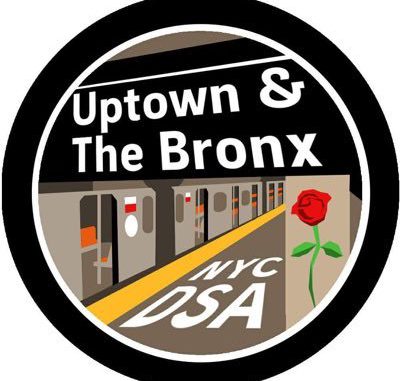
By Avi G
Last month, the uptown groups that fought the city’s rezoning of Inwood won a surprise victory: Manhattan Supreme Court Judge Verna Saunders ruled in favor of the community groups who had sued the city and annulled the zoning change. This ruling abruptly vindicated years of tireless organizing by activists and provided hope for a new community-based land use movement. DSA members were active at every step of the way, raising $1000 for an anti-rezoning block party, tabling, testifying at the hearings, marshalling at protests, and taking arrests at a street action.
Background
For decades, rezonings of manufacturing districts to residential use have been a tool for New York City’s government to create value for private landowners. Lifting restrictions on residential use pushes land values into the stratosphere—value that is captured by private owners—and creates the permissive regulatory conditions that led to waterfront gentrification in Williamsburg and other neighborhoods during the Bloomberg years. Mayor de Blasio proposed a similar “upzoning” on the industrial Inwood waterfront, with the promise of some below-market housing to make the plan look progressive.
A coalition of tenant groups, congregations, business owners, and preservationists reacted strongly against the proposed zoning change. These groups turned out hundreds of local residents to hearings, occupied Councilmember Ydanis Rodriguez’s office, demonstrated, and got arrested in the streets of Inwood. The coalition also wrote an alternative community plan that the city ignored. Once the city council voted to approve the rezoning, organizers mostly diverted their energies to the state rent law fight. But some devoted themselves to challenging the rezoning in court.
The ruling
The ruling hinged on an interpretation of the guidelines for City Environmental Quality Review (CEQR), a process that accompanies city-led land use changes. The plaintiffs in the lawsuit named eight areas of environmental impact (including racial impact and displacement) that the city’s Economic Development Corporation had flatly refused to study. To be clear, they had not claimed there would be negligible impact, or that the impact was worth it. They claimed that there was no requirement under CEQR that those impacts be studied at all. Saunders dismissed the EDC’s reasoning, on the grounds that CEQR process requires public input — and why take public input at all if it cannot trigger changes to the impact study?
This surprise ruling is one of a series of setbacks for Mayor de Blasio’s zoning and land use policy, and suggests that the political winds have shifted against the paradigm which has been the status quo since Bloomberg. Since the ruling last month, the Southern Boulevard rezoning has been aborted and the Bushwick rezoning is in deadlock over de Blasio’s refusal to talk to activists. Organizers in Western Queens are on the offensive after scaring off Amazon. The de Blasio administration plans to appeal, so unfortunately, the future of Inwood’s waterfront hinges on the obscure preferences of the New York Court of Appeals.
What’s next?
From community groups to borough presidents, New Yorkers are fed up with the land use status quo. But what is to come? Socialists need a vision for land use that rejects “market urbanism,” puts working-class communities first, and empowers them to shape the city around them through a participatory, democratic process. In Inwood, coalition members are going door-to-door to hear from the people who actually have living investments in the fabric of our neighborhood, and revising the alternative plan drafted two years ago. We will also be pressuring 2021 candidates to hear us out. De Blasio is committed to seeing his failed zoning plan through to the bitter end, but his days in the driver’s seat are numbered.
